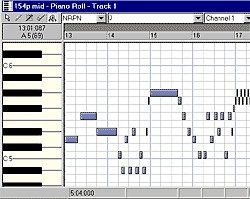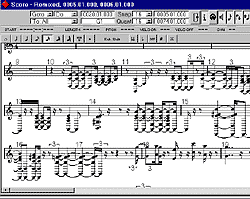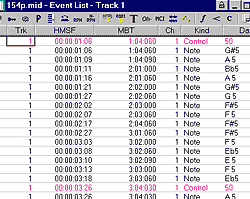What is MIDI?
(article by Paul Alan Smith
02/02/02)
MIDI is an acronym for "Musical
Instrument Digital Interface". It was originally
created in 1983 to enable synthesizer keyboard players to transmit keyboard
"events". MIDI synthesizers,
samplers, drum machines, and computers can be connected using special 5-pin MIDI
cords. Sounds on another device (synthesizer or sampler keyboard or module) can be remotely triggered. With a keyboard
connected to a computer via MIDI, performances can be recorded, multi-tracked,
processed with effects, edited, and mixed-down in a variety of sophisticated
digital audio software programs.
Game systems like Nintendo and Sega
have long used MIDI technology to keep their music file downloads smaller and
quicker. With the advent of the internet, MIDI files have become important
as a music source that downloads quickly. QuickTime players contain a
built-in MIDI player and can even display "karaoke" MIDI files that
highlight text lyrics in time to the music. In professional recording
studios, MIDI is often used to create the original tracks for hit songs, helping
humans stay on the beat (or "IN SYNC") when they overdub live performances. Some of the
MIDI tracks themselves often make it to the final CD mix (like "NSYNC").
Using MIDI to Create
a "One-Man-Band"
One popular MIDI utilization for live
performance: One keyboard can be connected via MIDI to other keyboards and
synthesizer "modules".

- The main "controller" keyboard itself, assigned to
Channel 1, outputs a "Grand Piano" sound.
- Every key played below the "middle
C" key sends MIDI to the second keyboard on Channel 2 which is set to a
"Fretless Bass" sound.
- Every key from "middle C"
up triggers the synthesizer module on Channel 3 which outputs a "Trumpet"
performance.
When the performer plays on his
keyboard with 2 hands, the audience hears the left-hand part (the green keys) as
Fretless Bass from the
second keyboard, the right-hand part (red keys) as Trumpet from the module, and both hands
as Grand Piano from the performer's keyboard. If each audio output from
the keyboards and module are sent to different speakers, it sounds like a
perfectly synchronized live trio of musicians, literally, a one-man-band.
About MIDI Events
Keep in mind that MIDI information is
like a player piano roll; it doesn't contain an actual recording of audio, just
a record of all "events". Once inserted into the player piano
machinery, it makes the keys play, recreating a performance. A
typical MIDI message might "set channel 1 to harpsichord and play the third D note for 2
seconds".
Some common MIDI events are :
- "note on"
- "note off"
- "volume"
- "pitch bend" (usually
controlled with a little wheel to the left of the keyboard)
- "instrument patch #"
(piano, tuba, drums...)
- "keyboard key #" (C3 is
"middle C")
- "channel #" (normally 16
Channels or less; one for each keyboard or module)
- "velocity" (how hard did
the key get hit)
The information transmitted is NOT the
actual audio that a synthesizer keyboard sends to the amplifier and
speakers. It is only the actions performed plus current settings. When a key is
pressed, the MIDI information is sent. If a "MIDI clock" is
turned on and transmitted, then the MIDI information can be recorded and saved
as a specially compiled text file (normally with the extension,
".mid"). In digital audio software programs with a "MIDI event editor"
it looks something like
this:
| Channel |
Track |
Time |
Data
Type |
Data |
Velocity |
| 1 |
1 |
00:00:00:00 |
Instrument # |
001 (piano) |
|
| 2 |
2 |
00:00:00:00 |
Instrument # |
057 (trumpet) |
|
| 10 |
3 |
00:00:00:00 |
Instrument # |
128 (drumkit) |
|
| 1 |
1 |
00:00:00:00 |
Volume |
100
(0-126) |
|
| 2 |
2 |
00:00:00:00 |
Volume |
83 |
|
| 10 |
3 |
00:00:00:00 |
Volume |
110 |
|
| 1 |
1 |
00:00:00:00 |
Note On |
C3 (middle
"C") |
97 |
| 1 |
1 |
00:00:00:30 |
Note Off |
C3 |
|
| 1 |
1 |
00:00:00:40 |
Note On |
C4 (high
"C") |
110 |
| 2 |
2 |
00:00:00:40 |
Note On |
E4 (high
"C") |
112 |
| 10 |
3 |
00:00:00:40 |
Note On |
C1 (bass drum) |
115 |
| 1 |
1 |
00:00:01:00 |
Note Off |
C4 |
|
| 2 |
2 |
00:00:01:00 |
Note Off |
E4 |
|
| 10 |
3 |
00:00:01:00 |
Note Off |
C1 |
|
| 10 |
3 |
00:00:01:00 |
Note On |
C1 (bass drum) |
115 |
| 10 |
3 |
00:00:01:10 |
Note On |
D1 (snare
drum) |
125 |
| 10 |
3 |
00:00:01:20 |
Note On |
C1 |
115 |
| 10 |
3 |
00:00:01:30 |
Note On |
D1 |
125 |
| 10 |
3 |
00:00:01:40 |
Note On |
C1 |
115 |
| 10 |
3 |
00:00:01:50 |
Note On |
D1 |
145 |
In the event list above, you can see
that the Instrument #s and Volumes were set for each track at time
"00:00:00:00" and one "middle C" piano note was
"triggered". Track 3 was set to the special Channel 10, which
is normally reserved for drum sounds. The piano note was
turned off at "00:00:00:30". After that, you can see a few
more note events for trumpet and piano, and the bass drum and snare drum
alternating at the end, with a louder "145" velocity hit on the snare
at the very end.
Up to 16 Channels can be used,
with corresponding Tracks for different Instruments. A Track can be
thought of as one player's performance (multiple notes are okay) on a particular
Instrument. Track and Channel (and Instrument) assignments can easily be
altered at any time, but it is good practice (less chance of MIDI logjam or
hiccups) to keep 1 Instrument on 1 Track on 1 Channel.
Connecting a MIDI
Keyboard to Your Computer
First, you'll need a MIDI
keyboard. These are available at music instrument shops, on the internet,
and sometimes in department stores. If you're looking for an inexpensive
keyboard to get started, try a Casio or Yamaha (make sure it has MIDI In and
MIDI Out ports on the back panel) from Toys R Us; you should be able to get one for
around $150 or less. High quality MIDI synthesizer/keyboards with great
sounds, velocity-sensitivity (transmits how hard you hit each key), weighted
(like a real piano) keys, and other features can go for about $1,000 and up.
You need two 5-pin MIDI
cords to connect to the MIDI In and MIDI Out connectors of your keyboard. |
 |
Now you need a MIDI In and
a MIDI Out connector on your computer. Some PCs come equipped, but may
need a cord adapter (to connect to "game/MIDI" ports, for
example). Some sound cards, like SoundBlaster Platinum include MIDI
ports. Another solution is to get a MIDI adapter box like "MidiSport";
it plugs into your computer's USB port, and offers 2 or more MIDI connections,
depending on the model. This is a less expensive solution than a new sound
card, and works fine on a Mac computer, too. |
Using MIDI Software
You'll need a software
program to record, edit, and play back your MIDI files. There are a lot of
decent, inexpensive programs (a few free ones) out there; check out the appendix
at the end of this article.
For the Macintosh, you might consider downloading ProTools Free; it's a pro
audio and MIDI recorder/editor optimized for the Mac, and it's FREE from
Digidesign's website. PC owners with Windows 98SE or ME operating systems
can use it, too.
There are several
"high-end" digital audio/MIDI combo programs that are being used to
create the hits you hear on the radio. ProTools is one of them,
but the high-end, "non-free" versions of ProTools with custom soundcard runs up to
$10,000 and beyond! Steinberg's Cubase VST (PC
and Mac) is as popular, and similar in features, but more reasonably priced;
also, if you can show a student I.D., you are eligible for a huge discount at
educational software sites (see appendix at the end of this article). For the PC only, there is
Cakewalk's new "Sonar"; it's also reasonably priced, with a very professional set of tools, a moderately
easy learning curve, and good manual. Digital Performer, Emagic Logic
Audio, and Nuendo are very popular with big music studios with many complex
features like surround sound mixing, and a correspondingly high learning curve.
Once you are connected,
you need to make sure that your software is able to
"hear" the MIDI input. On a PC, most programs can utilize the
Windows drivers and MIDI controller in the Multimedia/Sounds control
panel. You may need select from the software's MIDI menu to "choose
MIDI device", etc. On the Macintosh, you should install and run
Opcode's "OMS" (Open Music System), which helps streamline instrument
patching.
Recording MIDI to
Your Computer
If you have
"MIDI-aware" software, your keyboard is on, and your MIDI connections
are connected, then you're ready to lay down a track!
-
Go to your software's
main editing window, pick "Add a New Track" from the File or Edit
menu and make sure it's a MIDI, not an "Audio" track.
-
Most programs have a
"Record-enable" button (it may be a tiny red "rec")
somewhere on the left of the new Track; push the button. This is NOT
the regular Record button you see on the transport bar below; it's a switch
to "enable" recording on a particular Track, leaving other Tracks
safe from accidental overwriting.
-
Hit a key on your
keyboard while watching the software's "level meters" (you may
need to select the level meter from a "Windows" or "Views"
menu). If you see the bars jumping as you play, then you're in
business. If you don't, check to see if your MIDI Track has an input
selection; you may need to assign your keyboard to the Track.

-
Find the
"metronome" settings (sometimes you can just double-click on the
metronome's icon - it's the lit-up blue & white button next to the
"2 Bars" button on the Transport Bar above); make sure the
metronome is set to "click when
recording".
-
Set the
"Tempo"; 120 BPM (Beats Per Minute) or "quarter
note=120" is a normal, easy-going "groove".
-
On the "Transport
Bar" (the Play, Stop, Rewind, Record buttons, etc.), press the red
"Record" button.
-
You'll hear the
metronome start to click; "1,
2, 3, 4, 1, 2, 3, 4..." ("1"s are
emphasized).
-
Play to the
beat.
-
When you're done,
click the "Stop" button on the Transport Bar.
-
You now have a MIDI
Track displayed in the "Edit" Window.
Editing MIDI
Changes can be made in any
view and will show in the other views, subsequently. Notes can be dragged
to different locations, copied and pasted, and all MIDI values can be altered as
needed. MIDI can even be created from scratch within these programs
(without a keyboard!) using a pencil tool to draw in new notes and then
assigning values.
The Piano Roll view makes it easy to select and modify groups of notes (e.g.
snap them to a timegrid-"quantizing" or move them up or down the
scale-"transposing"). Some musicians prefer to edit in the Staff
Sheet mode, which can also be printed out for live musicians' use. Technically
oriented users may enjoy working with the complete data displayed in the Event
List view. It is also useful for tracking down "invisible"
events that may be causing problems.
"Sequences" of
MIDI tracks can be created and arranged as a "Song". A
"verse" section of 8 measures (8 times of "1, 2, 3, 4") can
be copied and pasted into another part of the song. The second verse might
be a copy of the first verse with the trumpet and drum tracks deleted.
Once your song is arranged, it can be saved as a standard MIDI file (extension
".mid").
Combining MIDI and
Audio
In the high-end digital
audio "workstation" programs like Cubase, ProTools, Sonar, etc. it is
common practice to begin creation of a piece by laying down MIDI drum tracks,
overdubbing other instruments onto more MIDI tracks, and then overdub audio
tracks like vocals and "live" instruments. Sometimes the MIDI
instruments are replaced one track at a time by a live performance, adding the
human feel of timing imperfections, natural instrument noise, and volume
dynamics. Some processing effects are only available to audio tracks, so a
good MIDI track might be routed out and recorded back as audio onto another
track, which can then be effects-processed. The final mix of audio and/or
MIDI tracks can be saved as stereo files for audio CDs, movie soundtracks, web
delivery, etc.
Good Things About
MIDI
The file size of the MIDI
information is very small, especially when compared to the same sounds recorded
and saved as digital audio. If you know the destination system that your
music is being sent to has a MIDI player installed, then you can use a MIDI file
to cut down web download times and/or system RAM requirements.
Also, MIDI files, being made of the
individual events, can be easily edited, as all of the individual instrument
data is still separated. Contrast this to a "mixed-down" stereo
(2 tracks) digital audio ".wav" file. None of the individual
performances within the mixed-down file can be isolated (as MIDI
can).
If you have a computer, you don't even
need an instrument to create MIDI music.
One MIDI file may include many tracks
of different instruments playing together simultaneously. You don't need
to learn how to play clarinet to create a clarinet performance.
If you're a songwriter, then you can
make your own demos with a full band, without having to pay anybody!
Not-So-Good Things
About MIDI
If your MIDI file is
played back on a computer or keyboard with cheezy MIDI sounds, your file sounds
bad.
MIDI can only trigger the
sounds that are in the MIDI library. That library does not contain your
voice, or the sound of screeching tires, or bagpipes (But it DOES have accordian!).
You can't make an entire song that includes vocals and special sounds...yet.
Some "special
effects" like "backwards audio" and "wah-wah" are only
available for audio files...so far.
If you aren't a musician,
it may be difficult to learn but, hey, you're brilliant... it might be fun!
Appendix: Where to
find MIDI Stuff
Here is a list of links
that I have found useful:
"Shareware Music Machine" site:
www.hitsquad.com/smm/
.
Academic discounted software:
www.academicsuperstore.com
ProTools Free download
site: www.digidesign.com/ptfree/
Cakewalk Sonar site: www.cakewalk.com
Steinberg Cubase site: www.steinberg.net
ToysRUs keyboards: www.toysrus.com
(search for "midi")






